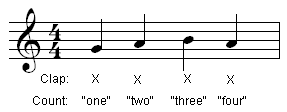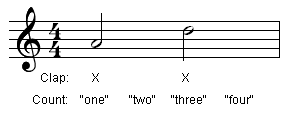Counting
Once we know how to determine the number of beats that each note receives, we can learn how to count the notes in a measure.
Count the beats out loud, while clapping the notes. Then, listen to the audio clips to hear the correct rhythm, and to hear how the music sounds.
A measure of four quarter notes in 4/4 time would be counted like this:

A measure of two half notes in 4/4 time would be counted like this:

Another example:

You can see that you just clap wherever you see the notes in relation to the beat. Continue to follow this pattern; further examples will not illustrate the clapping as distinct from the notes.
Remember that the beat is a steady pulse, so make sure that when you're counting, the numbers fall at regular intervals.
When the beat is divided in half, use the word "and".

In any measure in which you see eighth notes, it's helpful to use "and" between all the beats. This helps you to keep the numbers at even intervals.
If the beat is divided into four parts, it's customary to use "e" (pronounced "ee") and "a" (pronounced "uh")

Notice again that you count the whole measure with the smallest subdivision. So if you have eighth notes in a measure, you say "and" between each of the beats, and if you have sixteenth notes in a measure, you say "ee and uh" between each of the beats. This is called "subdividing the beat", or "subdividing the measure", and it helps you to maintain a steady beat.